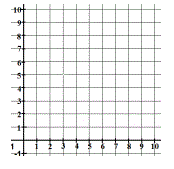| Problem |
Hint |
 1) A parallelogram has vertices at (0, 0), (5, 2), and (1, 3).
1) A parallelogram has vertices at (0, 0), (5, 2), and (1, 3).
The fourth
vertex has positive coordinates. What are they?
|
1. Plot the points on the graph.
2. Since the opposite sides of a parallelogram are parallel, the third vertex (1,3) and the 4th vertex are parallel to the first and second.
3. The offset of the second vertex from the first is
going from the first to the second: (___,___).
4. Apply this offset to the third vertex to find the 4th =
(___,___).
|
|
2) Jenny build a pyramid out of sugar cubes to model a Mayan pyramid. Each layer is a solid
square of sugar cubes and the pyramid looks the same on all four sides. The bottom layer shows 10
cubes along each side. The next layer shows 9 cubes along each side and so on ending with one
cube on top. Jenny paints all the surfaces of the pyramid that are showing. How many cubes have
no paint on them? |
1. If you lay out a square of cubes, 10 on a side (the bottom layer), then that makes _____ total cubes.
2. The cubes on just this one layer that will not have paint are the ones on the inside, making a square that is ____ cubes on a side.
3. Apply this to the remaining layers to compute the number of cubes that will not have any paint = _____ cubes.
|
3) At six o'clock the angle between the hour and minute hands on a clock is 180 degrees. What is the angle
between the hour and minute hands on the clock at 6:30 pm? Assume that both hands move at a
constant rate.
|
1. At 6:30 the minute hand has moved 180 degrees from 0 to ____ degrees .
2. 30 minutes is _____ of a 12-hour clock face = ____ degrees. This is how much the hour hand has moved from 180 =
____ degrees.
3. Subtract the two to get the angle between them =
_____ degrees.
|